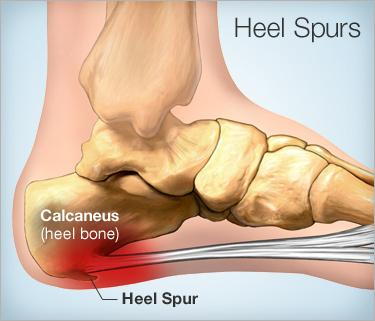At Southern Maryland Foot & Ankle, we are dedicated to helping our community stay informed about common foot conditions. One issue that many patients experience is heel spurs. These small, bony growths that form on the underside of the heel can cause significant discomfort and may interfere with your daily activities. In this blog post, we’ll dive into the causes, symptoms, and treatment options for heel spurs, so you can take steps toward managing this condition effectively.
What Are Heel Spurs?
Heel spurs are calcium deposits that accumulate over time, creating a bony protrusion on the bottom of your heel bone (the calcaneus). While heel spurs themselves are not always painful, they are often associated with conditions such as plantar fasciitis, where inflammation of the tissue connecting your heel to the toes leads to irritation and discomfort.
Causes of Heel Spurs
Heel spurs develop gradually over time and are often caused by repeated strain on the foot muscles and ligaments. Some of the common contributing factors include:
- Overuse: Running, jogging, or standing for long periods, especially on hard surfaces, can lead to heel spurs.
- Foot structure: People with flat feet or high arches are more prone to developing heel spurs due to uneven weight distribution.
- Improper footwear: Shoes that don’t offer adequate arch support or cushioning can contribute to heel spur formation.
- Age: As we age, the natural wear and tear on our feet can increase the likelihood of heel spurs.
- Obesity: Carrying excess body weight places additional strain on the heel and plantar fascia, increasing the risk of spurs.
Symptoms of Heel Spurs
While some people with heel spurs experience no symptoms, others may develop heel pain, especially during activities like walking, running, or standing for extended periods. Common symptoms include:
- Sharp pain in the heel, particularly in the morning or after periods of rest.
- A dull ache that persists throughout the day.
- Inflammation and swelling at the front of the heel.
- Difficulty walking or engaging in activities that involve pressure on the heel.
It’s important to note that heel spurs don’t always cause pain on their own. The discomfort often stems from associated conditions, such as plantar fasciitis, which causes inflammation of the tissue around the spur.
Diagnosing Heel Spurs
If you suspect you have heel spurs, the team at Southern Maryland Foot & Ankle can help. During your visit, we will:
- Take a thorough history of your symptoms and activity level.
- Perform a physical exam to assess your foot and pinpoint areas of tenderness.
- Order imaging tests such as X-rays to confirm the presence of heel spurs and rule out other conditions.
Treatment Options for Heel Spurs
The good news is that most cases of heel spurs can be treated effectively with non-invasive therapies. Here are some common treatment approaches:
1. Rest and Ice
Giving your feet a break from high-impact activities and applying ice to reduce inflammation can help alleviate pain.
2. Orthotic Inserts
Custom orthotic devices or over-the-counter shoe inserts can provide better arch support and relieve pressure on the heel, promoting healing.
3. Physical Therapy
Stretching and strengthening exercises for the calf muscles and plantar fascia can improve flexibility and reduce tension in the heel.
4. Anti-Inflammatory Medications
Over-the-counter nonsteroidal anti-inflammatory drugs (NSAIDs) such as ibuprofen can help manage pain and swelling.
5. Corticosteroid Injections
In cases of severe pain, corticosteroid injections may be recommended to reduce inflammation and provide temporary relief.
6. Surgery
Surgery is rarely necessary but may be considered in chronic cases where conservative treatments have not been effective. During surgery, the heel spur may be removed, or the plantar fascia released to reduce strain on the tissue.
Preventing Heel Spurs
Prevention is key to avoiding heel spurs, especially if you’ve had them in the past. To minimize your risk, consider the following tips:
- Wear supportive shoes: Opt for footwear with good arch support and cushioning, particularly during physical activity.
- Stretch regularly: Stretching your calf muscles, Achilles tendon, and plantar fascia can reduce tension on the heel.
- Maintain a healthy weight: Managing your weight can help reduce strain on your feet and lower your risk of developing heel spurs.
- Use orthotics if needed: Custom orthotics can help correct foot imbalances and relieve pressure points.
When to See a Specialist
If you are experiencing persistent heel pain, it’s time to seek professional advice. At Southern Maryland Foot & Ankle, we specialize in diagnosing and treating a wide range of foot and ankle conditions, including heel spurs. Our experienced team will work with you to develop a personalized treatment plan tailored to your needs.
Conclusion
Heel spurs are a common cause of heel pain but can be effectively managed with the right combination of treatments. If you suspect you have a heel spur or are dealing with persistent heel pain, don’t hesitate to reach out to Southern Maryland Foot & Ankle. We’re here to help you get back on your feet—pain-free!
For more information or to schedule an appointment, contact us today!

